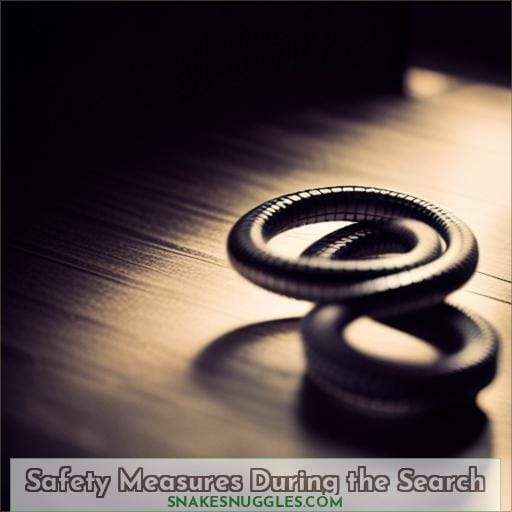This site is supported by our readers. We may earn a commission, at no cost to you, if you purchase through links.
 Imagine this: you have a small pet snake, and it’s gone missing in your house.
Imagine this: you have a small pet snake, and it’s gone missing in your house.
Don’t panic just yet! Snakes are master escape artists, but they can survive for quite some time without food. In fact, most snakes can last 4-5 weeks without eating and some even longer. However, finding your lost snake should still be a top priority to ensure its safety and well-being.
So let’s dive into the fascinating world of searching for a lost snake in your house!
Table Of Contents
- Key Takeaways
- Searching for a Lost Snake in Your House
- Safety Measures During the Search
- Post-Discovery Snake Care
- Case Study: TIE Fighter’s Disappearance and Discovery
- Places You Can Find a Lost Snake in Your House
- Frequently Asked Questions (FAQs)
- What are some common signs that a snake may be hiding in your house?
- How can I ensure the safety of my family and pets while searching for a lost snake?
- What steps should I take after discovering a lost snake in my house?
- Can a lost snake survive without access to its regular food source?
- How can I prevent my snake from escaping its tank again in the future?
- Conclusion
Key Takeaways
- Unusual nooks, unexpected crevices, and cozy corners provide hiding spots for snakes in a house.
- Snakes can survive for weeks without regular food by slowing down their metabolism.
- Community support and volunteer networks play a crucial role in search and rescue efforts for lost snakes.
- Implementing preventive measures such as securing doors, sealing gaps, and regularly checking traps can help prevent snakes from getting lost in a house.
Searching for a Lost Snake in Your House
When searching for a lost snake in your house, it’s important to consider the possible hiding spots that these elusive creatures may seek refuge in.
Dark spaces under furniture, wall cracks, attics, and kitchen cabinets are just a few examples of where they might be lurking.
To aid in locating them, various luring methods can be employed such as using flour trails or creating warm confined rooms to attract the snakes out of hiding.
Taking calm and calculated actions during the search while ensuring safety measures are also crucial for successful retrieval.
Possible Hiding Spots
When searching for your lost snake in your house, it’s important to consider its possible hiding spots.
These could include:
- Unusual nooks
- Unexpected crevices
- Cozy corners
- Surprising hideouts
Snakes are masters at finding hidden recesses where they can stay concealed and feel safe. They may seek warmth under furniture or in wall cracks, nestle into attics or basements, or even find comfort among piles of clothes or inside kitchen cabinets.
Be thorough in your search and check every potential hiding place!
Luring Methods
To increase your chances of luring a lost snake out of hiding in your house, try implementing these effective and practical methods:
- Utilize behavioral patterns to appeal to the snake’s instincts.
- Employ scent trailing by placing familiar scents or food around the house.
- Provide thermal attraction by creating warm environments near potential hiding spots.
- Use auditory cues such as soft hissing sounds or gentle tapping noises.
- Lastly, employ visual stimulation with objects that mimic prey movements or natural surroundings.
Actions During Search
As you search for a lost snake in your house, continue to carefully explore potential hiding spots and take proactive measures to locate the elusive reptile.
Implement emergency protocols such as securing other pets and avoiding panic.
Conduct thorough nighttime searches using surveillance methods like torchlights.
Notify neighbors with a photo if there’s a chance the snake has ventured outside.
Utilize strategic search strategies, including tape placement to trace the snake’s movements.
Safety Measures During the Search
When searching for a lost snake in your house, it’s crucial to handle the situation with caution and care.
- Keep calm to avoid startling or causing aggression in the snake.
- Take steps to prevent its escape by ensuring doors are closed and secure.
- Be mindful of family members’ safety by keeping them away from the search area.
- Regularly check traps for effectiveness.
Handling the Situation
During the search for a lost snake in your house, it’s important to handle the situation calmly and cautiously.
Use calming techniques like deep breaths and positive affirmations to stay composed.
Employ communication methods such as softly speaking or playing soothing music to create a peaceful environment.
Patience strategies are crucial; give the snake time to come out of hiding on its own terms.
Take safety precautions by wearing protective gloves and keeping children and pets away from potential danger zones.
Understanding snake behavior will aid in successful retrieval without causing harm.
Preventing Escape
Keep doors closed to prevent the snake from escaping.
Monitor entrances and ensure that all windows are tightly shut.
Create barriers by sealing any gaps or cracks in walls, floors, or furniture where the snake could hide or slither through.
Secure ventilation systems with mesh screens to block potential entry points for the snake.
Minimize clutter in your house to reduce hiding spots and make it easier to locate the lost snake during your search.
Consider seeking professional assistance if needed for a safe and effective resolution.
Remember that snakes can be quite agile when trying to escape, so it’s essential to take proactive measures during your search efforts while ensuring everyone’s safety within your household environment.
Ensuring Family Safety
You should always regularly double-check traps to ensure they’re intact and effective in ensuring your family’s safety during the search for a lost snake.
It’s crucial to prevent any potential interaction between the snake and other pets, such as dogs or cats, to avoid conflicts or bites.
Implementing emergency protocols and educating children about safe handling practices are essential measures for maintaining family safety.
Additionally, taking necessary household precautions like securing doors and keeping family members away from potentially dangerous situations can help minimize risks during the search process.
Post-Discovery Snake Care
After discovering a lost snake in your house, proper post-discovery care is crucial to ensure its well-being.
Tank management is essential, including checking and sealing any gaps to prevent future escapes.
Providing optimal living conditions such as sand, rocks, and trees within the tank will help create a comfortable environment for the snake.
Additionally, regular verification of tank security helps maintain safety for both the snake and household members.
Tank Management
After discovering your lost snake, one of the essential steps is to properly manage its tank.
Snake enrichment plays a crucial role in ensuring their well-being.
Focus on habitat security by checking for any gaps or openings in the enclosure that could lead to future escapes.
Temperature regulation is vital, so monitor and maintain appropriate heat levels within the tank.
Consider enclosure design and substrate selection carefully to create a safe and comfortable environment for your snake’s post-discovery care.
Providing Optimal Living Conditions
Once the snake has been discovered, it’s important to ensure that they’re provided with optimal living conditions for their well-being.
Consider the snake’s habitat preferences and make necessary behavioral adjustments.
Provide environmental enrichment in their tank, such as hiding spots and climbing structures.
Maintain appropriate temperature regulation to mimic their natural environment.
Lastly, establish proper sustenance strategies by offering a varied diet of prey items suitable for your specific snake species to promote overall health and vitality.
Regular Verification of Tank Security
Regularly verify the security of your snake’s tank to ensure a safe and comfortable environment. Inspection importance can’t be overstated when it comes to preventive checks for potential escape routes or weak points in containment.
Conduct routine maintenance by inspecting:
- Locks
- Hinges
- Any areas where the snake could potentially breach its enclosure.
Regular security assessments will help identify any vulnerabilities and allow you to take immediate action to ensure proper containment for the well-being of your pet snake.
Case Study: TIE Fighter’s Disappearance and Discovery
Now, let’s delve into a fascinating case study that sheds light on the topic of snakes surviving lost in houses.
One notable example is TIE Fighter, who went missing for three months before being discovered in a basement on Stoddard Ave by tenants. Despite rescue efforts and the involvement of Amanda Sprouse, her son Kingston, Eileen Conway, and Kelsey Robitaille, removing TIE Fighter from the insulation posed significant challenges.
This case offers valuable insights into both the resilience of snakes and the collaborative efforts required to ensure their safe return.
Missing for Three Months
When your snake goes missing for three months, you may be left wondering where it has been hiding all this time. In the case study of TIE Fighter’s disappearance and discovery, several survival techniques and emotional impacts were observed.
- Survival Techniques:
- Avoiding detection by retreating into insulation.
- Evading rescue attempts with bait and enclosures.
- Emotional Impact:
- Relief experienced by owners upon locating the lost snake.
- Gratitude towards those involved in the rescue efforts.
In the intriguing case of TIE Fighter’s disappearance and subsequent discovery after three long months, we witness a fascinating display of survival techniques employed by snakes when faced with an unfamiliar environment within our homes.
The emotional impact on both owners and rescuers further highlights their resilience amidst such challenging circumstances.
- Survival Techniques
During its extended absence from home, TIE Fighter displayed remarkable adaptability to ensure its own survival:
- Retreating into Insulation: When initially spotted on a basement camera, instead of being easily captured or lured out as expected, TIE Fighter quickly retreated into insulation as a means to camouflage itself from potential threats.
- Evading Rescue Attempts: Despite various tactics used to lure it out with enticing baits or enclosures strategically placed throughout its hiding spot in Stoddard Ave basement., TIE Fighter managed to cleverly elude capture until alternative methods could be explored.
- Emotional Impact
The prolonged absence of a beloved pet can take an immense toll on one’s emotions; however,the eventual reunion brings about overwhelming relief:
- Relief Experienced By Owners: After tirelessly searching for their missing companion for an extended period,during which hope might’ve wavered,Tie Fighters’ owner Amanda Sprouse was undoubtedly filled with immense relief at finally discovering her elusive friend alive.
As we delve deeper into these remarkable stories of survival and emotional impact, we gain a greater understanding of the lengths snakes go to ensure their own well-being when faced with unfamiliar surroundings.
The unknown whereabouts and subsequent discovery of TIE Fighter offer invaluable insights into both the astonishing survival techniques employed by these creatures and the profound emotional impact such experiences have on their human counterparts.
Rescue Efforts and Contributors
During TIE Fighter’s three-month disappearance, multiple contributors and rescue efforts were instrumental in locating and rescuing the lost snake.
Volunteer networks, utilizing various rescue techniques such as an endoscope, worked tirelessly to track down TIE Fighter.
The community rallied together to support the rescue process and express their gratitude towards those involved. This case study highlights the importance of community engagement in successfully recovering a lost snake in your house.
| Rescue Efforts | Contributors |
|---|---|
| Utilized volunteer networks | Amanda Sprouse |
| Employed various rescue techniques | Kingston (Amanda’s son) |
| Encountered communication challenges | Eileen Conway |
Rescue Process and Challenges Faced
To successfully rescue a lost snake in your house, you might encounter various challenges and obstacles along the way.
From elusive escapes to hidden obstacles, snakes have a knack for evading capture.
During the rescue process, unexpected challenges can arise, such as difficulty removing the snake from insulation or finding it avoiding detection tools like an endoscope.
However, rescuers provide reassurance and expertise to overcome these hurdles and ensure a safe recovery of the lost snake.
Community Support and Reactions
After TIE Fighter’s disappearance and subsequent discovery, the community rallied together in support of the snake’s rescue efforts.
Owner perspectives were filled with emotional impact as they experienced unexpected returns of their beloved pets.
The joy of reuniting with a lost snake brought immense relief and happiness to these owners, who found solace in the supportive communities that came together during these trying times.
Future Initiatives and Continued Support
Continuing the efforts to support lost snake rescues, let’s delve into the inspiring case study of TIE Fighter’s disappearance and discovery.
- Volunteer networks
- Reptile education
- Community engagement
- Innovative rescue strategies
By establishing these initiatives, we can ensure a more coordinated approach to locating and safely recovering lost snakes in residential areas. Together, we can make a difference in protecting both these fascinating creatures and our communities.
Places You Can Find a Lost Snake in Your House
When searching for a lost snake in your house, one of the key areas to check is under furniture and large items where they may hide.
Snakes are known for their ability to squeeze into tight spaces, so it’s important to thoroughly search these areas.
Don’t forget about inside appliances like washing machines or dishwashers, as snakes can sometimes find their way inside.
Outdoor gear such as camping equipment or gardening tools should also be examined carefully.
Electronic devices with small openings or vents can provide hiding spots for snakes as well.
Indoor plants are another favorite spot for them to conceal themselves due to the abundance of foliage and warmth provided by sunlight.
Finally, don’t overlook unused furniture that has gaps or crevices where a snake could easily slip away unnoticed.
Frequently Asked Questions (FAQs)
What are some common signs that a snake may be hiding in your house?
Some common signs that a snake may be hiding in your house include:
- Finding shed skin, droppings, or tracks.
- Unexplained noises or movement behind furniture and walls.
How can I ensure the safety of my family and pets while searching for a lost snake?
To ensure the safety of your family and pets while searching for a lost snake:
- Keep calm to avoid startling or provoking aggression.
- Secure other pets.
- Discreetly place treats along traps.
- Regularly check traps for effectiveness.
What steps should I take after discovering a lost snake in my house?
After discovering a lost snake in your house, it’s crucial to handle the situation calmly.
Avoid startling the snake and secure family members.
Check for any possible hiding spots and carefully move the snake back to its tank for safety.
Can a lost snake survive without access to its regular food source?
A lost snake can survive without access to its regular food source for weeks, thanks to their ability to slow down their metabolism. However, it’s important to locate and provide sustenance for the snake as soon as possible for its well-being.
How can I prevent my snake from escaping its tank again in the future?
To prevent future snake escapes, ensure your tank is secure by:
- Checking and sealing any gaps.
- Creating an optimal living environment with sand, rocks, and trees.
- Regularly verifying tank security for the safety of both your snake and household members.
Conclusion
To wrap it up, finding a lost snake in your house requires:
- A systematic and thorough search
- Implementing safety measures to prevent further escape and ensure family safety.
Once the snake is discovered, proper care and maintenance are crucial to its well-being.
A case study of TIE Fighter’s disappearance and subsequent rescue efforts highlights the importance of community support and future initiatives.











